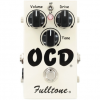yek
Contact Fractal for your Custom Title

Fulltone OCD
| Description | A modern overdrive/distortion classic with a wide gain range |
| Yek’s Tip | Use the channels of the Drive block to dial in the model with various amounts of gain |
| Original Controls | Volume (Level), Drive (Drive), Tone (Tone), Low Peak/High Peak switch |
Fulltone’s Full-Drive is discussed elsewhere in this guide. Mike Fuller followed up on the success of that pedal with the best-selling Obsessive Compulsive Drive or OCD. It’s a modern MOSFET-based overdrive / distortion with a very wide gain and dynamic range. It’s said to be one of the few pedals that nails the warm sound and response of a driven tube amp convincingly. It was an instant hit with guitar players, including famous ones such as Keith Urban, as well as bass players. Also, the OCD has always been affordable.
“The OCD was the first pedal to use Mosfets as clipping devices. Another first was their configuration as "hard clippers connected to v-ref" instead of to ground, as was the norm. These things contribute greatly as to why the OCD has such touch-sensitivity...why they react so well when the strings are hit hard or soft, and why they sound & feel different than all other pedals out there, 90% of which are just slight tweaks of the Tube Screamer.” — Fulltone
“The Fulltone Obsessive Compulsive Drive (OCD) is an extremely open sounding Overdrive/Distortion circuit that differs from other overdrives in that it has a good bit more Dynamic-Range...meaning the difference between picking soft or picking hard will actually yield a more natural and wider range of distortion (with less compression) than traditional diode-clipped overdrives. The OCD also creates complex overtones without changing the inherent tone of whatever amp and guitar you’re playing through, in the process lifting off that blanket other drive pedals can put on your signature sound.
The OCD accomplishes its tube-like distortion through the unusual combination of overdriving its JFET opamp, and then hard-clipping with a pair of MOSFETs later on in the circuit. This topography did not exist in a pedal prior to the OCD, and the circuit works very well with a vast array of guitars and amps. Because of its large amount of available output volume, the OCD works great as a booster in front of amps to goose them into submission, as well as through Master-Volume amps to drive them much harder than most OD‘s can, but it also excels at creating its own distortion with all the chime of a Class A amp and its complex array of overtones. The OCD gives you the feeling that your amp is Cranked at even living room volume so Clean playing is more dynamic and dirty sounds still have the ringing overtones. The OCD’s can access a slew of other in-between sounds by simply turning up or down your guitar’s volume control, in fact, no other pedal “cleans up” like the OCD.” — Manual
Fulltone released the OCD V2 in 2017. But before that, the original OCD (V1) already had been changed 7 times by Fulltone (versions 1.1 – 1.7). It’s unknown so far which V1 version of the OCD Fractal Audio has modeled.
Reviews:
The pedal has 3 knobs:
- Drive: amount of overdrive (model: Drive)
- Tone: controls tone, noon is neutral (model: Tone)
- Volume: output level (model: Level)
The Drive control covers an enormous range of gain. At low settings it works great as a boost, like a Tube Screamer. Turn it up and you’ll discover the potential of this model, from a mild crunch into high gain. It excels at any position and it isn’t hard to see why the pedal is so popular.
Last edited:




